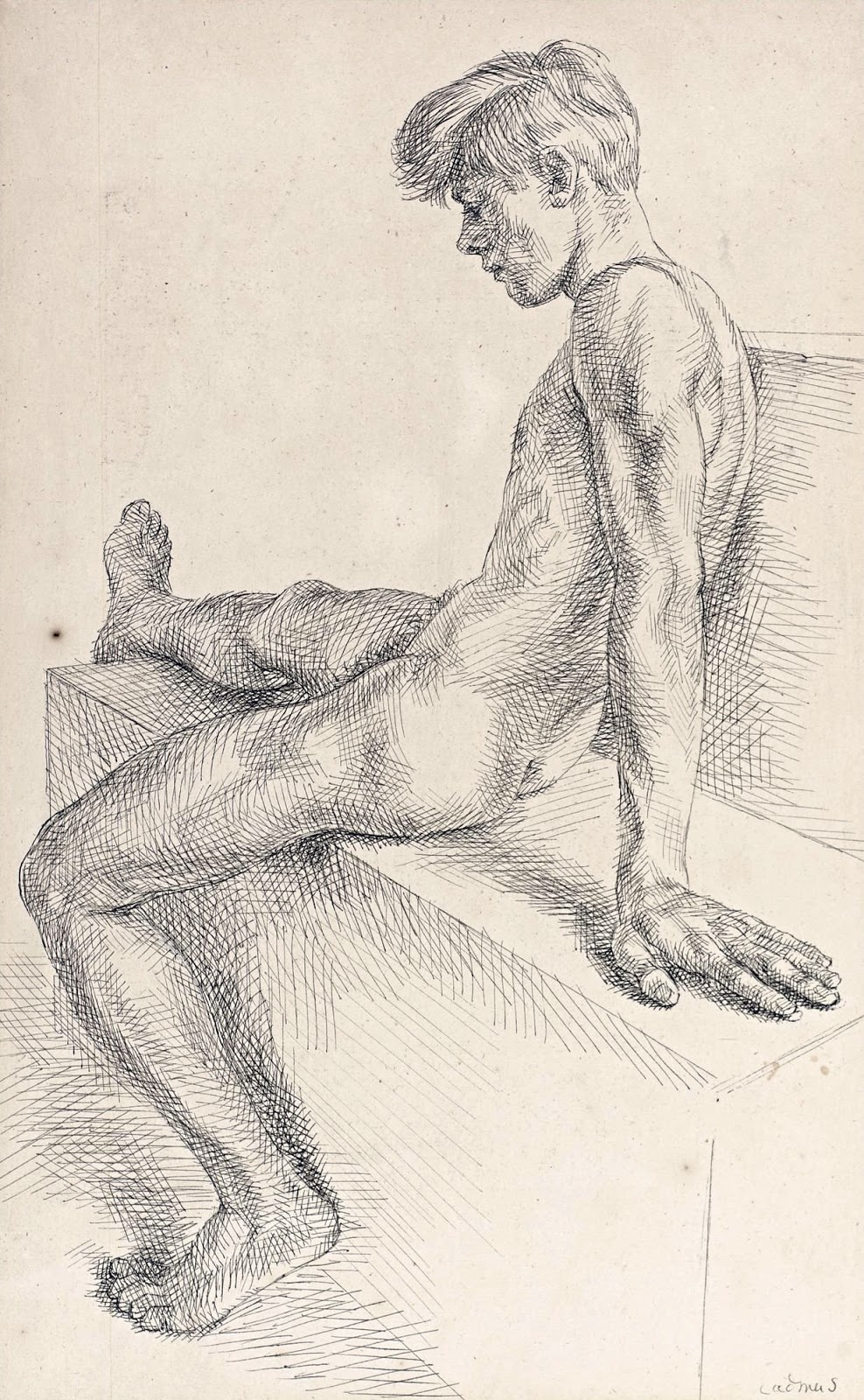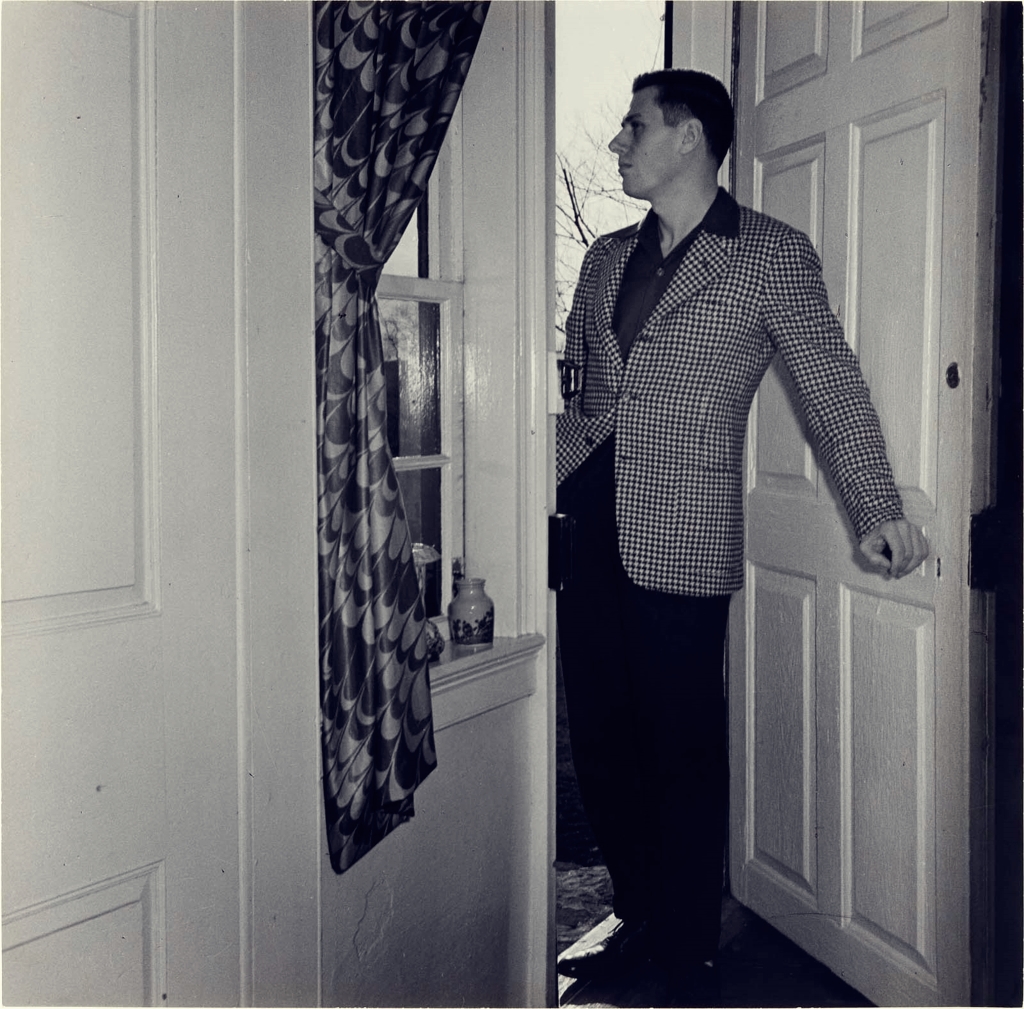Suspiciously it vanished for decades from the public view, only later to turn up in the possession of a deceased admiral. That painting, as well as many of Paul Cadmus‘s subsequent paintings and drawings, featured heroic tight muscled handsome young men, and Paul Cadmus was later recognized as one of the first contemporary American artists to chronicle what was later to be called “the gay lifestyle.
Paul Cadmus recalled in an interview with Howard Feinstein for the magazine “The Advocate” regarding “The Fleets In” and other contemporaneous works
“I was just recording what I saw and thought I knew, I certainly was not trying to foster “gay rights” at the time.
Cadmus was a native-born New Yorker; he was born December 17, 1904, and grew up on the streets and tenement blocks of the Upper West Side, near Amsterdam Avenue and 103rd Street. His parents were both artistically gifted, his father was a commercial artist who worked advertising industry, and his mother illustrated children’s books before her marriage, however, the family, which included Cadmus’s younger sister, was still quite impoverished. New York was in one of its many transitional phases, poverty was all around and the Great Depression was just around the corner to make matters worse.Cadmus told something of his early life and conditions to Judd Tully in an interview for the “Smithsonian’s Archives of American Art” he said, “our apartment was in a horrid tenement building and we lived there crowded with other poverty-stricken working families, we lived every day with cockroaches and bedbugs, inadequate heating in the winter and inadequate cooling in the summer months”. It’s also known that PaulCadmus suffered from rickets a condition brought on by poor diet and vitamin deficiencies, but that was New York in the early 1900’s millions were living in the same conditions. Paul Cadmus goes to Europe.The National Academy of Design is where his parents had met and at the age of fourteen, Paul Cadmus followed in their footsteps and enrolled in art classes there. Not long afterwards Paul Cadmus dropped out of state high school and encouraged by his parents entered the Academy as a full-time art student.Cadmus had an early fascination with the art of the Italian Renaissance a period that is the foundation of all classical art as we know it today, a period that had to rediscover the fundamental principles of human figurative geometry. Paul Cadmus studied and perfected these principals earnestly and this can be seen in all of his beautiful and sensitive depictions of his male models later in his career.Paul Cadmus spent in total six years at the Academy winning many accolades prizes and scholarships there before he finally moved on in 1924 to spend the last two years of academic training at the Art Students League of New York City. At the end of his training, Paul Cadmus was an accomplished artist and illustrator and found his skills in great demand, plenty of work came his way in the “golden age of the newspaper and print advertising”.By 1930 Cadmus had found a permanent position working for a small New York advertising agency, however, Paul Cadmus had further and greater ambitions, he wanted to follow in the hallowed footsteps of so many great American artists and writers, many of whom had embellished and honed their artistic careers by leaving the homeland and sailing to Europe, where coincidentally, the American Dollar went along very way In the autumn of 1931 along with an old friend and fellow student from the Art league, Jared French, Paul Cadmus set off for Europe, they intended to live frugally and paint as and when they wished, with nothing to encumber them, like working to a deadline or paying bills.Paul Cadmus and Jared French found their way to the Balearic Islands just off the Mediterranean coast of Spain the main island of which is Majorca, it was not the tourist trap it is today and the two artists spent two years there in languid artistic creativity until their finances were depleted. Paul Cadmus later recalled in the interviews with Tully “I actually painted a small amount of Majorcan subjects, most of the paintings I painted there were scenes that were in my memory from my American experiences, the Shore Leave painting, Sailors Night, The Locker Room. He seemed to enjoy the irony of the situation. Tully later recalled.When Cadmus and French got back to America the whole country was in the midst of a severe economic depression brought on by the 1929 Wall Street Crash, it would not fully recover until the advent of the Second World War so Paul Cadmus or for that matter any artist found it very difficult to find work. Cadmus applied for and received a position on a government program that paid him a subsistence wage of $32 a week to paint for the Public Works of Art Project. Within a couple of months of working on the public art project, Cadmus had produced two artworks: Greenwich Village Cafeteria and the infamous The Fleet’s In. “The Fleet’s” it was exhibited at the Corcoran Gallery (where Robert Mapplethorpe’s work would also be censored much later) in Washington DC where it caused quite a stir and controversy. As mentioned earlier in this article, the painting reveals handsome young US matelote’s on shore leave, carousing with gaudily attired young women who look likely to be prostitutes all of the characters seem to be in an unrestrained mood that is undoubtedly being helped along by alcohol. All of this was controversial enough with the Navy brass, however, in the left-hand segment, a sailor is shown accepting a cigarette from an effete looking gentleman in a grey suit. The gentleman is wearing a red tie and this was considered at the time to be one of the secret dress code signals that homosexual men used to identify one another. One must remember that all of this took place way before the Gay Liberation Movements of the 1960s.This was a time when gay men were almost always forced to remain closeted for fear of legal, social and professional retribution. Paul Cadmus – The scandal that brought him to public attention.All this, of course, was an aspersion too far for the Navy and some of the more conservative public, it caused a hue and cry within the Navy Department and of course was gleefully transmitted and stoked by the Washington Evening Star. The Newspaper printed both an article and a photo of the “salacious and deprived painting” a day before the opening of the exhibition and a retired US Navy admiral “Hugh Rodman” read the newspaper article and was outraged at the representation of his beloved Navy and the homocentric aspersions it cast upon it.Rodman pulled strings and used his influence to get the Paul Cadmus painting removed from the exhibition before it opened for public display. Now a feeding frenzy of comment and lambasting came as national Newspapers picked up on the “Cadmus painting scandal” the admiral went so far as to suggest that the painting should be destroyed and describing it “as an insult to the enlisted men of the US Navy” and “this is an image that originated in the depraved mind of someone who has no experience or conception of the conditions in our beloved naval service” Paul Cadmus in his own defence of The Fleet’s In!Told the New York Times he had painted the scene from his own personal firsthand experience of watching sailors come ashore at the navy pier 96th street New York. In the same interview, Cadmus said “admiral Rodman and the Navy brass who are so angry must govern an Alice in Wonderland navy dream world, they should take a stroll along the drive at night when the fleets in port” Cadmus also admitted that he had received threatening calls and had to stay away from his apartment for a few days. Most of the controversy around The Fleets In!Concerns the painting’s depiction of navy sailors carousing and drinking with women but in reality, it was the pick-up between the two men in the painting that was most offensive to the establishment of the time. Remember this was a time when homo-eroticism was virtually invisible in normal society and although it had been subtly utilized in graphical art for some time one had to be aware of the signals to understand the connotations, the Paul Cadmus painting was readable to all but the most naive.There was nothing ambiguous about it at all. Meanwhile back in Washington DC, former admiral Rodman had managed to get the painting removed from the Corcoran Gallery Exhibition, they could do this officially because Paul Cadmus was a government employee working for the Public Works of Art Project. The painting now confiscated found its way to the Navy Department and finally the cousin of the President, assistant secretary of the Navy, Henry Latrobe Roosevelt took it home with him to make sure that the painting never is shown in public and to save the Navy from further embarrassment. “There is no such thing as bad publicity” that’s the way the old newspaper saying goes and Paul Cadmus was to find the truth about that.The scandal generated huge publicity and notoriety for the young artist and Cadmus would later say that it was Admiral Rodman he had to thank for his national fame and success. Paul Cadmus continued to paint images that displeased both the authorities and the general public who generally required to be flattered by their own portrayal. One of these works that again sired up controversy was the 1935 painting “Coney Island” which was to be featured in an exhibition at the Whitney Museum that year. However, the residents and business operators of Coney Island thinking, rightly so, that the painting gave a not too flattering impression of Coney Island visitors, threatened to sue the museum and the painting was withdrawn under protest from Cadmus admirers of whom he now had plenty. When the Public Library in Port Washington, New York was being built under the auspices of the WPA, Paul Cadmus was asked to submit his ideas and sketches. Murals were a fashionable form of decorating public and private building projects in the 1930’s Think 1933 Rockefeller centre and Diego Rivera, many now revered and famous artists earned a living in hard times working in this field. In this particular case, Paul Cadmus’s work was rejected because he wanted to paint satirical murals depicting the leisure pursuits and habits of the American affluent society.This was the early 1930’s artists everywhere were espousing socialist ideas just like Rivera, Paul Cadmus was no exception but the board rejected his political sarcasm for the Library project. Cadmus later took the concept he originated for the library project and transformed it into a series of his most famous paintings Aspects of Suburban Life: Aspects of Suburban Life: Golf and Main Street were all paintings that were snapped up by private collectors, as was all of his work in this period, for now, he was represented by the renown prestigious Midtown Galleries of Madison Avenue. The Paul Cadmus 1937 Exhibition received over seven thousand visitors, phenomenal viewing figures for the time, Cadmus’s notoriety was paying off and he enjoyed being in the spotlight. Paul Cadmus was no longer the critics choice in the years immediately following World War II, the popularity and style of Paul Cadmus’s work started to wane with critics and the public alike. Still deeply rooted in social realism perfected by him in the 1930’s it became passé and out of fashion. Now a revived and rejuvenated America was looking for something more modern, less cerebral, more colourful and expressive of the new post-war era. Art critics who once has applauded his audaciousness now dismissed him as a risqué irrelevance and compared his work to the over folksy Norman Rockwell but with a more debauched subject matter. His work was now starting to be rejected by Museum curators and exhibition organizers who thought that any Paul Cadmus entry would upset both the local and art communities.Egg Tempera had been Paul Cadmus’s preferred medium since the early 1940s, it was a painstaking process harking back to his early admiration of the Renaissance, however, painting this way could take him up to six months to finish a painting and this along with his growing social and fashionable irrelevance diminished his career considerably in this period. The Paul Cadmus stat was fading but it never was completely extinguished and was mealy waiting for time to pass and a new appreciation of his brilliance to be appreciated by a new generation of art lovers. Paul Cadmus produce only two paintings a year up until the late 1980s, working out of a tradition sky lit studio at his home in Weston Connecticut USA. The home and studio had been a gift from his brother-in-law and director of the New York Ballet: Lincoln Kirstein. Kirstein was one of many eminent friends and admirers of his work that Cadmus had gathered close over the preceding years. Luminaries from the world of ballet such as George Balanchine writers and academics like W. H. Auden, and Christopher Isherwood. E. M. Forster all were close friends of Cadmus. Time and a new audience finally rediscovered Paul Cadmus in the 1980s, interest was rekindled when the painting that made him infamous The Fleets In!Went on public display, at last, having been found and liberated from a private gentleman’s club in DC. Cadmus had been unaware of what had happened to the painting after the confiscation by Admiral Rodman and its subsequent trip to the Naval Office.He later discovered that when Henry Roosevelt died in 1936 he had wrongly bequeathed the painting to “The Alibi Club in Washington DC. The painting hung there for years unbeknown to anyone in the art world or Camus himself; however, it came to light when a graduate student doing his dissertation discovered it and then mounted a successful legal challenge to have it returned to public ownership. Later to become the author of a book on Paul Cadmus, Philip Eliasoph argued that because Cadmus was being paid at the time from the public purse of the Public Works of Art project that taxpayers money had paid Cadmus for the painting and therefore it should belong to the public. Eliasoph won the case and now the painting can be seen regularly in museum Exhibitions throughout the USA. From the beginning of 1964, John Anderson who was a former cabaret singer and performer lived with Paul Cadmus as his partner. John can be seen in the David Sutherland 1986 PBS Documentary about Paul Cadmus entitled “Paul Cadmus, Enfant Terrible at 80” John can also be seen in many of Paul Cadmus’s drawings and paintings as he was the model for many of Paul’s Paintings and etchings, John is the tall handsome guy usually depicted angelically with long flowing blond curls.Paul Cadmus died on December 12: 1999 a few days short of his 95th birthday, he died at the home and studio at Weston Connecticut that John and Paul had shared for over 35 years together. | © Kings Gallery Corp



























Reference: https://www.tuttartpitturasculturapoesiamusica.com/




